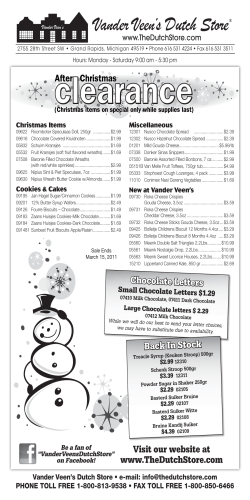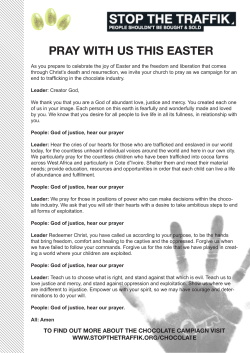
Y Roald Dahl
Gale Contextual Encyclopedia of World Literature – 2nd 10/23/2008 11:39 Page 437 D-E Y Roald Dahl BORN : DIED : 1916, Llandaff, South Wales 1990, Oxford, England NATIONALITY : GENRE : English Novels, short stories MAJOR WORKS : Over to You: Ten Stories of Flyers and Flying (1946) James and the Giant Peach (1961) Charlie and the Chocolate Factory (1964) The BFG (1982) Matilda (1988) Overview A writer of both children’s fiction and short stories for adults, Roald Dahl (1916–1990) is best known as the author of Charlie and the Chocolate Factory. Dahl’s works for children have been praised as skillfully crafted, with fast-paced plots, captivating detail, and onomatopoetic words that lend themselves to being read aloud. His adult-oriented short stories are noted for their dark humor, surprise endings, and subtle horror. Whether writing for juveniles or an adult audience, Dahl has been described as a master of story construction with a remarkable ability to weave a tale. Works in Biographical and Historical Context Boarding School: Source of Darkness Dahl was born in Llandaff, South Wales, to Norwegian parents and spent his childhood summers visiting his grandparents in Oslo, Norway. After his father died when Dahl was four, his mother honored her late husband’s wish that Dahl be sent to English schools. Dahl subsequently attended Llandaff Cathedral School, where he began a series of academic misadventures. After he and several other students were severely beaten by the headmaster for placing a dead mouse in a cruel storekeeper’s candy jar, Dahl’s mother moved him to St. Peter’s Boarding School and later to Repton, a renowned private school. Later, Dahl recalled in his short autobiographical story ‘‘Lucky Break’’ that the ‘‘beatings at Repton were more fierce and more frequent than anything I had yet experienced.’’ Standing six feet, six inches tall, Dahl played soccer and served as the captain of the squash and handball teams but did not excel in academics. One teacher commented on the fourteen-year-old boy’s English composition work: ‘‘I have never met a boy who so persistently writes the exact opposite of what he means. He seems incapable of marshaling his thoughts on paper.’’ One year later, another comment on an English composition of Dahl’s read: ‘‘A persistent muddler. Vocabulary negligible, sentences mal-constructed. He reminds me of a camel.’’ Dahl would later describe his school years as ‘‘days of horrors’’ that inspired much of his macabre fiction. Plane Crash: An Unusual Beginning Dahl was flying over the African desert for the Royal Air Force during World War II when he was forced to make an emergency landing. He was rescued by another pilot and transported to a hospital in Alexandria, Egypt. His skull was fractured and plastic surgery was necessary to repair the damage to his nose. Six months later, he had recuperated to the point that he could fly a Hurricane fighter with his squadron in Greece against the Germans. Dahl shot down four enemy planes, and his own plane was one of the four out of the thirty Hurricanes in that campaign to survive. Then, as Dahl’s old injuries began to cause dangerous blackouts when he flew, he returned to England. At a club one night, he met the undersecretary of state for Air, Harold Balfour, and Balfour gave Dahl his next post as an assistant air attaché in Washington, D.C. While it took Dahl six months to recover—and he would live with the recurrent pain of his injuries for the rest of his life—Dahl’s crash landing set him on a course 437 Gale Contextual Encyclopedia of World Literature – 2nd 10/23/2008 11:39 Page 438 Roald Dahl understanding of the kind of stories children enjoyed. In an article for The Writer, Dahl observed that children love suspense, action, magic, ‘‘new inventions,’’ ‘‘secret information,’’ and ‘‘seeing the villain meet a grisly death.’’ According to Dahl, children ‘‘hate descriptive passages and flowery prose,’’ and ‘‘can spot a clumsy sentence.’’ As Dahl’s children grew older, he wrote both Charlie and the Chocolate Factory, the story of a poor boy who is selected to be the new owner of a world-famous chocolate factory, and James and the Giant Peach, which recounts the fantastic tale of a young boy who travels thousands of miles in a house-sized peach with as bizarre an assemblage of companions as can be found in a children’s book. Works in Literary Context Roald Dahl Dahl, Roald, photograph by Eli Wallach. The Library of Congress. that led him to his career as a writer. Wanting to write about Dahl’s most exciting war experience for a Saturday Evening Post article, reporter C. S. Forester interviewed Dahl over lunch one day in Washington. Because Forester could not eat and take notes at the same time, Dahl offered to write some notes later for the journalist. Those notes became the story ‘‘A Piece of Cake,’’ the first of Dahl’s work to bring him money and recognition. Dahl went on to write a number of stories for adults about being a fighter pilot. In Dahl’s first book for children, he did not stray far from the fighter-pilot stories he had created for adults. The Gremlins tells the story of evil little men who caused war planes to crash. After these beings are discovered, they are convinced to work for the pilots instead of against them. The Gremlins was a popular success. After First Lady Eleanor Roosevelt read the book to her children, she invited Dahl to dinner at the White House. Walt Disney was so taken with the story that he planned to transform it into a motion picture. In the New York Herald Tribune Weekly Book Review, May Lamberton Becker advised her readers to preserve The Gremlins ‘‘as a firsthand source book on the origin of a genuine addition to folklore. That is, preserve it if the children in the family don’t read it to bits . . . .’’ Father and Storyteller The births of Dahl’s children provided him an opportunity to tell the children bedtime stories, a practice that allowed the author to develop his 438 Revenge and Violence One way that Dahl delights his readers is by exacting often vicious revenge on cruel adults who harm children. In Matilda, the Amazonian headmistress Miss Trunchbull, who deals with unruly children by grabbing them by the hair and tossing them out windows, is finally banished by the brilliant Matilda. The Witches, released as a movie in 1990, finds the heroic young character, who has been turned into a mouse, thwarting the hideous and diabolical witches’ plans to kill all the children of England. But even innocent adults receive rough treatment. In James and the Giant Peach, parents are eaten by a rhinoceros, and aunts are flattened by the eponymous giant peach. In The Witches, parents are killed in car crashes, and pleasant fathers are murdered in Matilda. However, Dahl explained in the New York Times Book Review that the children who wrote to him ‘‘invariably pick out the most gruesome events as the favorite parts of the books. . . .They don’t relate it to life. They enjoy the fantasy. And my nastiness is never gratuitous. It’s retribution. Beastly people must be punished.’’ Dahl’s Writings for Adults Over to You: Ten Stories of Flyers and Flying is a collection of Dahl’s early stories. One tale especially, ‘‘They Shall Not Grow Old,’’ is a much more polished story than one would expect from a relatively inexperienced writer. A notable aspect of this piece, also seen in several of the other stories in the book, is the clear influence of Ernest Hemingway on the young writer’s style. Critics have compared much of Dahl’s adultoriented fiction to the works of Guy de Maupassant, O. Henry, and Saki. Praised by commentators as well crafted and suspenseful, Dahl’s stories employ surprise endings and shrewd characters who are rarely what they seem to be. Dahl also experimented with comic themes in his novel My Uncle Oswald. The title character, Oswald Hendryks Cornelius, is a charming man of the world who embarks upon a business venture to collect and preserve semen samples from geniuses and royalty, hoping wealthy women who desire superior offspring will want to be his clients. Like Dahl’s short stories, My Uncle Oswald features duplicitous characters, and some critics have GALE CONTEXTUAL ENCYCLOPEDIA OF WORLD LITERATURE Gale Contextual Encyclopedia of World Literature – 2nd 10/23/2008 11:39 Page 439 Roald Dahl observed that it shares a common theme with much of his short fiction: a depiction of the superficial nature of modern civilization. LITERARY AND HISTORICAL CONTEMPORARIES Works in Critical Context Charlie and the Chocolate Factory Charlie and the Chocolate Factory is Dahl’s most popular and most controversial children’s story. Many critics have censured this work for its alleged stereotyping and inhumanity, and have accused Dahl of racism for his portrayal of the OompaLoompas. In the original version of the story, the OompaLoompas are described as black pygmies from deepest Africa who sing and dance and work for nearly nothing. In a revised edition, Dahl changed their appearance and gave them a mythical homeland. Still, claims of prejudice persist. In Now Upon a Time: A Contemporary View of Children’s Literature, Myra Pollack Sadker and David Miller Sadker criticized Charlie and the Chocolate Factory for its ‘‘ageism’’: ‘‘The message with which we close the book is that the needs and desires and opinions of old people are totally irrelevant and inconsequential.’’ The publication and popularity of Charlie and the Chocolate Factory evoked criticism from experts in children’s literature who thought that the violence, insensitivity, or supposed racism in the text was offensive or inappropriate for children. Many critics have objected to the rough treatment of adults. Eleanor Cameron, for example, in Children’s Literature in Education, found that ‘‘Dahl caters to the streak of sadism in children which they don’t even realize is there because they are not fully self-aware and are not experienced enough to understand what sadism is.’’ ‘‘It is difficult to avoid the feeling that Dahl . . . enjoys writing about violence, while at the same time condemning it,’’ remarked David Rees in Children’s Literature in Education, adding: ‘‘Dahl . . . parades his own irritations—television addiction . . . overindulgence in sweets, gum-chewing, shooting foxes, beards, ugly faces, fat bodies, cranky old people, spoiled children—and presents them as moral objections.’’ Dahl’s supporters have argued that in Charlie, as in his other children’s books, Dahl follows the traditional fairy tale style, which includes extreme exaggeration and the swift and horrible destruction of evildoers; they contend that children are not harmed by this approach. Critic Alasdair Campbell, writing in School Librarian, argued that ‘‘normal children are bound to take some interest in the darker side of human nature, and books for them should be judged not by picking out separate elements but rather on the basis of their overall balance and effect.’’ If critics disagreed about the suitability of some of Dahl’s books for children, most agreed that Dahl was a talented writer. According to Michael Wood of New Society, ‘‘Dahl is at his best when he reveals the horrible thinness of much of our respectability; at his worst and most tiresome when he nudges us towards the contemplation of mere naughtiness . . . what is striking about Dahl’s work, Dahl’s famous contemporaries include: Eleanor Roosevelt (1884–1962): First Lady of the United States from 1933 to 1945, Eleanor Roosevelt was a key figure in Franklin Delano Roosevelt’s New Deal policy, which helped the United States survive the Great Depression. C. S. Lewis (1898–1963): Lewis is best known for The Chronicles of Narnia (1965), which present the adventures of children who play central roles in the unfolding history of the fictional realm of Narnia, a place where animals talk, magic is common, and good battles evil. Ernest Hemingway (1899–1961): Just as Dahl’s earliest work was inspired by his experience in World War II, this American novelist’s writing is largely inspired by his service in World War I. Pablo Picasso (1881–1973): This Spanish artist worked in a variety of media, including paint and ceramics, and he is often associated with the cubist art movement. both for children and adults, is its carefully pitched appeal to its different audiences . . . . He has tact, timing, a clean, economic style, an abundance of ingenuity . . . above all he knows how to manipulate his readers.’’ Responses to Literature 1. Read one of Dahl’s children’s books and read one of his short stories written for an adult audience. What are some of the key differences between the ‘‘voices’’ of these texts? (Consider the words Dahl uses, the themes the works focus on, and the action within the texts.) 2. Read Charlie and the Chocolate Factory. Consider why Willy Wonka decides to give the chocolate factory to Charlie? If you were Willy Wonka, would you have chosen Charlie? What would have happened to the factory if Willy Wonka had chosen another child? BIBLIOGRAPHY Books Carpenter, Humphrey, and Mari Prichard. The Oxford Companion to Children’s Literature. Oxford: Oxford University Press, 1984. Georgiou, Constantine. Children and Their Literature. Upper Saddle River, N.J.: Prentice-Hall, 1969. McCann, Donnarae, and Gloria Woodard, eds. The Black American in Books for Children: Readings in Racism. Lanham, Md.: Scarecrow, 1972. Mote, Dave, ed. Contemporary Popular Writers. Detroit: St. James Press, 1997. GALE CONTEXTUAL ENCYCLOPEDIA OF WORLD LITERATURE 439 Gale Contextual Encyclopedia of World Literature – 2nd 10/23/2008 11:39 Page 440 Gabriele d’Annunzio Overview COMMON HUMAN EXPERIENCE Roald Dahl suffered a terrifying crash while a member of the Royal Air Force during World War II. Much of his adult-oriented literature deals with war and its effects on human beings. Following is a list of other texts that focus on the mental and emotional toll of war: ‘‘I Will Fight No More Forever’’ (1877), by Chief Joseph. This famous speech was given by Nez Percé chief Joseph upon his surrender to the U.S. Army. ‘‘Dulce Et Decorum Est’’ (1920), by Wilfred Owen. Owen, a soldier in World War I, wrote this poetic rebuttal to a line from Horace that claimed it is ‘‘sweet and appropriate’’ that a young man should die in war for his country. The Best Years of Our Lives (1946), a film directed by William Wyler. This Academy Award–winning film tells the story of three servicemen and the complications and struggles they face upon returning home after World War II. In the Lake of the Woods (1994), by Tim O’Brien. In this novel, the protagonist, John Wade, is a Vietnam veteran who continues to suffer from post-traumatic stress disorder, which causes him to experiences bouts of rage, perhaps resulting in the murder of his wife. Parker, Peter, ed. A Reader’s Guide to Twentieth-Century Writers. Oxford: Oxford University Press, 1996. Silvey, Anita, ed. Children’s Books and Their Creators. New York: Houghton Mifflin Co., 1995. Warren, Alan. Roald Dahl. Mercer Island, Wash.: Starmont, 1988. West, Mark T., interview with Roald Dahl. Trust Your Children: Voices against Censorship in Children’s Books. New York: Neal-Schuman, 1988, pp. 71–76. Wintle, Justin, and Emma Fisher. The Pied Pipers: Interviews with the Influential Creators of Children’s Literature. London: Paddington Press, 1975. Y Gabriele d’Annunzio BORN : 1863, Pescara, Italy DIED : 1938, Gardone, Italy NATIONALITY : GENRE : Italian Poetry, fiction, drama MAJOR WORKS : New Song (1882) The Child of Pleasure (1888) The Daughter of Jorio (1904) Halcyon (1904) 440 Italian novelist, poet, dramatist, and political agitator, Gabriele d’Annunzio is one of the most flamboyant personalities of twentieth-century literature. The press reported his romantic scandals, and scholars criticized the moral delinquency of his works. Nevertheless, d’Annunzio was celebrated in his lifetime as one of Italy’s greatest authors, an accomplished stylist who combined the poetic splendor of Dante and other classical writers with such literary movements as naturalism, Symbolism, and Decadence. Works in Biographical and Historical Context Father’s Influence Provides Opportunities for Education D’Annunzio was born March 12, 1863, in the small town of Pescara on the Adriatic coast in central Italy. His father, a prosperous landowner and a dealer in wine and agricultural products, became mayor of the town. His wealth and influence allowed d’Annunzio the opportunity to study with private tutors and to be educated in Latin by priests of the local diocese. Later, d’Annunzio was educated in a prominent boarding school in Prato: the Liceo Cicognini. Uninhibited Poetry Brings Success A precocious child, d’Annunzio excelled at Latin and Greek. At the age of sixteen, he wrote his first collection of verse, Primo Vere (1879; In Early Spring), which was published by his father. Because of its uninhibited approach to sexual themes, the poems were a commercial hit; because of their linguistic skill, they were a critical success. After graduating from Cicognini in 1881, d’Annunzio attended the University of Rome and began writing for newspapers. The following year, he published Terra vergine (1882; Virgin Land), a collection of regional stories, and Canto novo (1882; New Song), a collection of poetry that contains details of his first romantic relationship. In 1883, he married the duchess Maria Hardouin de Gallese, with whom he had three sons. D’Annunzio wrote popular stories, light verse, and a society news column, all under pseudonyms, in order to support his family. In 1888, after determining that his journalistic writing was consuming too much time, d’Annunzio quit his job as a reporter so that he could finish his first novel, The Child of Pleasure (1888–1889). During the 1880s in Rome, d’Annunzio perfected his metamorphosis into what some have called a fop, or dandy. Often writing under a pseudonym, a penchant he extended by immediately renaming women acquaintances, d’Annunzio sharpened his writing and shamelessly blended his flamboyant image and experiences into his sensual poetry and stories; the frank depiction of his seduction of his wife, Maria Hardouin, here named ‘‘Yella,’’ in Intermezzo de rime (1883), brought accusations of pornography, but boosted sales. GALE CONTEXTUAL ENCYCLOPEDIA OF WORLD LITERATURE
© Copyright 2026










